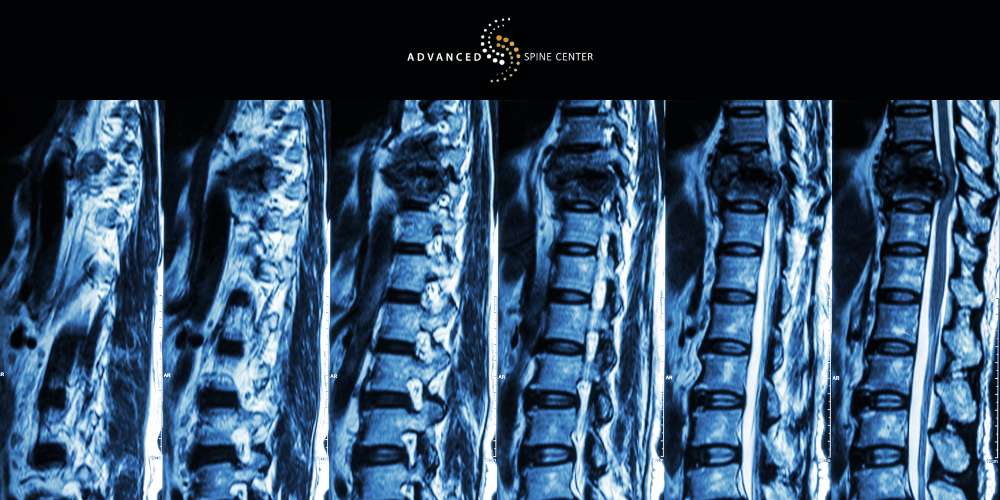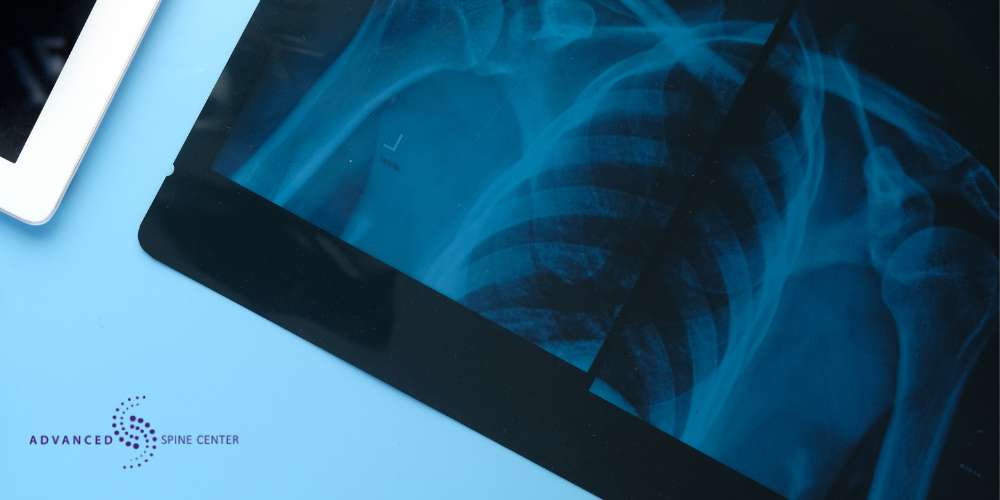Understanding Burst Fractures in the Spine
A burst fracture is a serious type of vertebral body fracture that occurs when a strong force, such as a car accident or a fall from a height, compresses the spine with extreme pressure. This can cause the vertebra to break into multiple pieces, sometimes sending bone fragments into the spinal cord and surrounding nerves, leading to potential paralysis, loss of bowel or bladder control, or long-term mobility issues.
Burst fractures most commonly affect the thoracic and lumbar spine, which bear much of the body’s weight and are highly susceptible to injury from sudden trauma. Because the posterior ligamentous complex plays a crucial role in stabilizing the spine, a burst fracture can compromise this structure, resulting in abnormal or excessive movement that further destabilizes the spine, as well as a potential spinal cord injury.
Understanding bone anatomy and the severity of these injuries is crucial, as burst fractures account for a significant portion of spinal trauma cases requiring surgical intervention. If you or a loved one has suffered a spinal injury, The Advanced Spine Center in Plano, TX, can provide an evaluation and personalized treatment.
Contact us at (972)-499-5457 today to schedule a consultation and protect your spinal health.
Anatomy of the Spinal Cord, Spinal Canal, and the Vertebral Body
The spinal cord is a delicate structure housed within the spinal canal, which is protected by the vertebrae that make up a healthy spine. Each vertebra consists of different structural components, including the posterior vertebral body cortex and the anterior and middle sections, all of which play a role in maintaining spinal stability.
The lumbar spine, in particular, is highly susceptible to fractures due to its weight-bearing function and exposure to major trauma, such as car accidents or falls. When a burst fracture occurs, the vertebral body can collapse, and sometimes, the spinal canal becomes compromised by displaced bone fragments, potentially leading to severe compression of the spinal cord.
In cases where the injury threatens neurological function or spinal stability, surgical intervention may be necessary to remove bone fragments, realign the spine, and restore its structural integrity.
What Is a Burst Fracture?
A burst fracture is a severe type of compression fracture that occurs when extreme force crushes a vertebra, causing it to break into multiple pieces. Unlike a standard compression fracture, which typically results in a partial collapse of the vertebral body, a burst fracture often leads to displaced bone fragments that can invade the spinal cord or spinal canal, potentially causing neurological deficits such as weakness, numbness, loss of bowel or bladder control, or even paralysis.
A lumbar burst fracture is particularly concerning because the posterior ligament complex, which helps maintain spinal stability, can be compromised, leading to an unstable spine. This type of serious injury requires immediate medical attention to assess the extent of the damage and determine the best course of treatment, which may include bracing or surgical intervention to stabilize the spine and prevent further injury.
Burst Fracture vs Compression Fracture
While both compression fractures and burst fractures involve the collapse of a vertebra, they differ in severity and potential complications. Burst fractures occur when the vertebral body breaks into multiple fragments, often spreading into the spinal canal, increasing the risk of a spinal cord injury and neurological deficits.
In contrast, a compression fracture typically results in a less severe, more contained collapse of the vertebra and is often classified as a stable fracture that may heal with conservative treatment. However, severe fractures—especially unstable spinal fractures—can lead to spinal deformity, chronic pain, and long-term mobility issues.
In cases where displaced bone fragments threaten the spinal cord, surgical decompression may be required to relieve pressure and restore spinal stability.
Maintaining good bone health through proper nutrition, weight-bearing exercises, and osteoporosis management can help reduce the risk of these fractures and promote a stronger, more resilient spine.
Burst Fracture Symptoms
A burst fracture can cause a range of symptoms, depending on the severity of the injury and whether the fractured vertebrae have displaced bone fragments into the spinal canal. The most immediate and noticeable symptom is severe pain at the site of the fracture, often worsening with movement.
If the injury affects spinal nerves or results in spinal cord damage, patients may experience neurologic deficits, including numbness, tingling, loss of bladder and bowel function, muscle weakness, or even paralysis.
In some instances, a fracture dislocation, where the vertebra shifts out of alignment, can further compress the spinal canal, increasing the risk of long-term complications. If not properly treated, a burst fracture may lead to chronic pain and the development of bone spurs, which can irritate surrounding nerves and contribute to ongoing discomfort and mobility issues.
Immediate medical evaluation is crucial to assess the severity of the injury and determine the best course of treatment to prevent long-term complications.
Common Compression Fracture Locations

Compression fractures can occur anywhere along the vertebral column, but are most commonly found in the thoracic and lumbar spine. T11 through L1 are extremely susceptible, as these vertebrae bear significant weight and stress.
These fractures often involve the posterior portion of the vertebra, including the posterior cortex and, in some cases, the posterior arch, which can contribute to spinal instability. When a fracture is severe enough to compromise vertebral body height, it may lead to unstable fractures that put pressure on the spinal canal and surrounding nerves.
In such cases, surgical treatment may be necessary to restore spinal stability and relieve nerve compression. Decompression surgery is often performed to remove bone fragments and ensure that the spinal cord and nerve roots are not at risk of further injury.
Early diagnosis and appropriate intervention are crucial to preventing long-term complications and preserving mobility.
Thoracic Burst Fracture
A burst fracture in the thoracic spine typically occurs in the T10 through L2 region, an area known as the thoracolumbar junction. This region is particularly vulnerable to injury due to the transition between the rigid thoracic spine and the more flexible lumbar spine.
Thoracolumbar burst fractures involve a collapse of the anterior and middle column of the vertebrae, often resulting from high-energy trauma such as car accidents or falls from significant heights. When the posterior vertebral body cortex remains intact, the fracture may be more stable, but if it is compromised, the injury can become highly unstable, increasing the risk of spinal cord compression.
Treatment options vary depending on the severity of the fracture, with some cases requiring bracing and physical therapy, while others necessitate surgical intervention to restore spinal stability and prevent long-term complications.
T12 Burst Fracture
A T12 burst fracture is a serious spinal injury that occurs at the lower end of the thoracic spine, a critical transition point between the thoracic and lumbar regions. This area is particularly vulnerable to thoracolumbar fractures, as it experiences significant biomechanical stress during trauma.
In a burst fracture at T12, the middle column of the vertebra is often compromised, causing the vertebral body to break into multiple fragments. This can lead to spinal instability and potential compression of the spinal canal, increasing the risk of neurological deficits.
Depending on the severity of the injury, treatment options may include bracing, physical therapy, or surgical intervention to stabilize the spine and prevent further complications.
Lumbar Burst Fracture
A lumbar burst fracture is a severe spinal injury that occurs in the thoracic and lumbar spine, typically due to high-impact trauma such as a car accident or a fall from a significant height. Unlike a simple compression fracture, a burst fracture involves the vertebral body breaking into multiple fragments, which can potentially encroach on the spinal canal.
This increases the risk of spinal instability, which can lead to pain, loss of mobility, and possible neurological deficits if the spinal cord or nerve roots are compressed. The degree of instability determines the course of treatment, which may range from bracing and physical therapy for stable fractures to surgical intervention for more severe cases.
L1 Burst Fracture
The L1 burst fracture is one of the most common thoracolumbar burst fractures, occurring at the junction between the thoracic and lumbar regions. The vertebral body in this area is particularly vulnerable to injury due to the transition from the rigid thoracic spine to the more flexible lumbar spine.
When an L1 burst fracture occurs, the vertebra collapses in multiple directions, sometimes sending bone fragments into the spinal canal, which can result in nerve compression and significant pain.
Treatment options depend on the severity of the fracture. Stable fractures are often managed conservatively using bracing and rehabilitation, while unstable fractures may require surgical stabilization to restore spinal alignment and function.
L2 Burst Fracture
An L2 burst fracture involves a severe break in the vertebral body, usually caused by excessive axial compression. This type of burst fracture can be particularly concerning if bone fragments move into the spinal canal, increasing the risk of nerve damage and impaired mobility.
The extent of spinal instability and neurological involvement determines whether the fracture can be treated conservatively with a brace or if surgical intervention is necessary. In severe cases, spinal fusion or decompression surgery may be required to prevent further complications and restore stability to the lower back. Early diagnosis and proper treatment are crucial for minimizing long-term effects and ensuring optimal recovery.
How Do We Diagnose a Burst Fracture in the Spine?

Diagnosing a burst fracture requires a thorough evaluation using advanced imaging techniques to assess spinal stability and potential nerve damage. Patients who have experienced significant trauma and exhibit neurological symptoms, such as numbness, weakness, or loss of sensation, will typically undergo a CT scan to get a detailed view of the fractured vertebra and any potential spinal dislocation.
Additionally, magnetic resonance imaging (MRI) is often used to evaluate damage to surrounding tissues, including the spinal cord and nerve roots, which can impact neurological function. If the fracture is severe and causes compression of the spinal canal, anterior decompression surgery may be necessary to relieve pressure on the spinal cord and restore stability. Early and accurate diagnosis is crucial for determining the best treatment approach and preventing long-term complications.
Burst Fracture Treatment Options in Plano, TX
Treatment for a burst fracture depends on the severity of the injury and whether there is spinal instability or neurological impairment. For neurologically intact patients, nonsurgical treatments such as bracing, prolonged bed rest, and physical therapy may be sufficient to promote healing while maintaining spinal alignment.
However, if the fracture leads to instability or a posterior ligamentous injury, surgical stabilization may be required to restore spinal integrity and prevent further complications. Spinal fixation procedures, such as a lumbar fusion or the use of rods and screws, can help stabilize the affected vertebra and promote long-term spinal support.
The Advanced Spine Center in Plano, TX, provides expert care for burst fractures, offering both conservative and surgical burst fracture treatment options tailored to each patient’s needs.
Life After Burst Fracture Injuries
Recovery from a burst fracture varies depending on the severity of the neurological injury and the treatment approach used. While most burst fractures heal with proper care, some patients may experience lasting effects, including chronic pain and mobility issues.
For cases requiring surgical intervention, the focus shifts to rehabilitation and strengthening the spine to regain function. Damage to the vertebral body or spinal cord can lead to neurologic deficits, such as weakness or loss of sensation, requiring ongoing therapy to improve quality of life.
The Advanced Spine Center in Plano, TX, offers comprehensive post-treatment care to help patients on the road to their recovery. With the right treatment plan, many individuals can regain independence, recover from injuries, restore mobility, and resume daily activities with minimal long-term complications.










